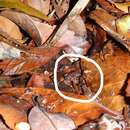Distribution and Habitat
(
الإنجليزية
)
المقدمة من AmphibiaWeb articles
Range and PopulationDisjunct distributions from the Conondale and Blackall Ranges in south-eastern Queensland south to the Dorrigo Plateau in north-eastern New South Wales. Populations also on the D’Aguilar, Main, Gibraltar and Border Ranges. The extent of occurrence of the species is approximately 36000 km2.Can be found in considerable numbers under good conditions. No data on population size, structure or dynamics.Habitat and EcologyPrefers mesic forests in areas with mild temperatures and moderate to high rainfall. Often amongst leaf litter.About 10 eggs are laid in a large mass of jelly on the ground in late summer. The male approaches hatching tadpoles and allows them to wriggle up onto his back and into hip pouches where they remain for about 2 months before emerging as tiny frogs.
Ehmann, H. and Swan, G. (1985). ''Reproduction and development in the marsupial frog, Assa darlingtoni (Myobatrachidae, Anura).'' Biology of Australasian Frogs and Reptiles. G. Grigg, R. Shine, and H. Ehmann, eds., Royal Zoological Society New South Wales, Sydney, 279-285.
Life History, Abundance, Activity, and Special Behaviors
(
الإنجليزية
)
المقدمة من AmphibiaWeb articles
In the past much of its habitat was cleared or logged for timber resources. A majority of its remaining habitat however is in protected areas.There is evidence to suggest that logging has a negative impact on this species.Conservation MeasuresMuch of habitat in protected areas. Listed as rare in Queensland and vulnerable in New South Wales.

